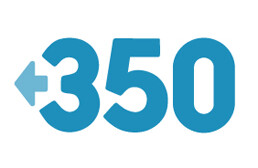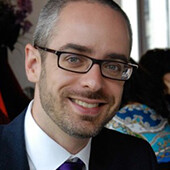Where do we draw the political and ecological lines on climate change? How much carbon will the atmosphere take? Policy Innovations Managing Editor Evan O'Neil talks with Phil Aroneanu, director of creative media for 350.org, an international campaign to limit greenhouse gas emissions. Phil and Evan met last year on the inaugural Climate Ride from New York to Washington.
EVAN O'NEIL: Phil, the number 350 is your campaign's rallying cry. Where does it come from?
PHIL ARONEANU: 350 is the safe level of carbon dioxide in the atmosphere in parts per million. It's a concentration, and it's been going up for the past hundred years—roughly since the Industrial Revolution started and we began burning coal, oil, and gas to power our economy.
We learned about the 350 target from Dr. James Hansen, a preeminent climate scientist, and the director of the NASA Goddard Institute of Space Studies at Columbia University in New York. He has studied the world's climate history, the temperatures and fluctuations in carbon dioxide in the atmosphere, and has shown that a number of so-called planetary "tipping points" happen at 350 ppm.
What that means is once we're past 350 ppm—and we're at 389 ppm now—we may begin to pass the point of no return in terms of ocean acidification, ice-melt in the Arctic, species decline, and a number of other systemic problems. We don't know what concentration exactly will hit those tipping points, but we know that we're in the danger zone.
The good news is that we can turn it around if we take action now to stop burning coal, oil, and gas, and stop cutting down huge swaths of trees in the developing world. That alone won't get us back to 350 ppm, but it's a good start. We're hoping 350—both as a policy target and as a symbol of a prosperous, clean-energy future—will become a rallying call to the world's leaders, so that as they negotiate the future of our planet in Copenhagen this December, they will have the public support to move boldly forward.
EO: James Hansen recently argued against cap and trade, instead favoring a tax and dividend system. Does 350.org side with him?
PA: 350.org doesn't take a policy stance on domestic legislation in the United States. What we want most is an international agreement that gets us on the road back to 350 ppm. That said, we're not completely oblivious to the importance of what the United States does domestically vis-à-vis other countries. What we want is the United States to go to Copenhagen with an equitable approach to the agreement and strong emissions targets in line with the science.
Targets should be in the range of 30 to 40 percent by 2020 and 80 to 100 percent by 2050. Anything less will lead us down the path of catastrophic climate change. In addition, the agreement should provide significant resources above and beyond those reductions towards technology transfer, adaptation for those hardest hit by climate change, and clean energy development in poor countries.
What would be worse than the United States going to Copenhagen with a weak mandate would be going to Copenhagen with no bill at all, and that's the tricky part. We don't feel that any of the proposals that Hansen, Reps. Waxman and Markey, and others have put forth are wrong—it's a matter of what we can do in this short window of time before Copenhagen that matters, and making sure that it gets us on the path to a fair agreement that passes the 350 test.
EO: What are the pressure points for the December climate negotiations in Copenhagen? Is the agreement that is taking shape strong enough?
PA: Right now in Bonn, Germany, delegates to the UN and ministers are editing the draft of the agreement—moving commas around, putting certain phrases in brackets and moving other phrases into the negotiating text. Last I saw, the 350 target was in the draft [in brackets] along with 450 ppm. We know that 450 gives us about a 50/50 chance of avoiding catastrophic climate change. We don't feel that 50/50 is good enough—would you drive across a bridge if there was a 50 percent chance that it would collapse into the water below?
We feel like many of the world's leaders want to do the right thing, but there's been an atmosphere of malaise and foot-dragging—a sort of UN bubble of sorts—where governments still spout the stale rhetoric of the past two decades. World leaders need to be jolted into action. This isn't time to take baby steps; we're already in the danger zone. We need a distributed mass mobilization of ordinary global citizens to let our leaders know that foot-dragging is no longer OK. That means pressuring everybody from your mayor all the way up to President Obama. Only a truly global grassroots movement will make enough noise in enough places to make the agreement happen.
EO: What sort of compromises will it take for COP15 to produce an internationally "equitable" agreement?
PA: I think there are many different conceptions of equity. Some equity advocates call for no carbon trading at all, understandably fearful that indigenous lands will be yanked out from under them to sell forest credits, or that carbon traders will make billions of dollars off the market while poor countries languish in poverty (Climate Justice NOW). Other people are calling for massive wealth redistribution, accounting for historical responsibility for CO2 emissions (Greenhouse Development Rights). Still others are calling for deeper cuts from developed countries based on a right to survival (Small Island States).
What is clear is that any agreement that doesn't provide a pathway out of poverty for the billions of people around the world who haven't built consumptive lifestyles based on carbon, as we have in the Global North, will not be a fair one.
EO: Activism of any sort takes a lot of dedication. What made you choose this path? Why the environment?
PA: I don't think I ever had an "aha!" moment. I've always been interested in nature and the environment. I'm an avid outdoorsman, and love to climb, ski, bike, run, camp, and do almost anything else outside. After I learned about climate change from my high school physics teacher in the late 90s, I helped launch No Car Day in my hometown, and sort of kept going from there.
I should note that activists—especially climate activists—must have some sort of fire within them to do the work that they're doing. To see the science getting worse day by day, but still have faith in humans and our collective power to change the world for the better, takes some chutzpah.
EO: What have you found most challenging as a climate activist?
PA: Climate change is a challenging issue mainly because many of us who are responsible for it won't feel it on our own skin in a significant way until it's too late. Communicating the urgency of the problem, and recognizing that nothing short of a complete transformation of our economy will solve it, is sometimes daunting. I'm optimistic that we'll solve the problem, and that I'll leave my kids with a planet that's still livable so that they can visit the special places in the world that I love, and discover new ones.
EO: You and I met during a special event last year, essentially a climate conference on bicycles. What made you decide to do Climate Ride?
PA: It was easy: I love biking, and my life's work is dedicated to solving climate change. It only seemed like a natural fit. Also, I wanted to help my friends who run Focus the Nation—they're good, hardworking organizers who, with few resources, have managed to engage thousands of educators, community leaders, and students around the country, and teach them about climate change. It's important to support projects like FtN because those are the people who will find new and innovative ways to make change, and stay one step ahead of the status quo.
EO: What was the most valuable thing you discovered as a rider?
PA: There were a variety of people on the ride, most of whom work on climate change in some way. It was incredibly useful for me to talk to people in the private sector who are actually producing the goods and services that are going to explode as we move beyond the carbon age. It was enlightening to hear their challenges, and inspiring to hear their plans for the future. It helped me envision the world of climate activism as a much broader movement, and made me feel that, yes, we can win this fight.
EO: 350.org is organizing a big climate action this year on October 24. What should people expect? How can they get involved?
PA: October 24 is going to be the widest-spread action on climate ever. We've already registered over 1000 actions in every corner of the globe. It's easy to get involved—all we're asking people to do is get together with friends, family, and neighbors at an iconic place near you and take a picture with the number 350 displayed prominently in the picture.
You don't ever have to have done something like this before, and we have lots of information, tools, and a page for each action at 350.org, where you can invite people, keep track of RSVPs, and post announcements. October 24 might seem like far away, but we want to make sure that each action is planned and ready to go so that our leaders know that we are holding them accountable.





